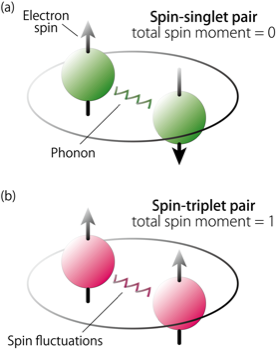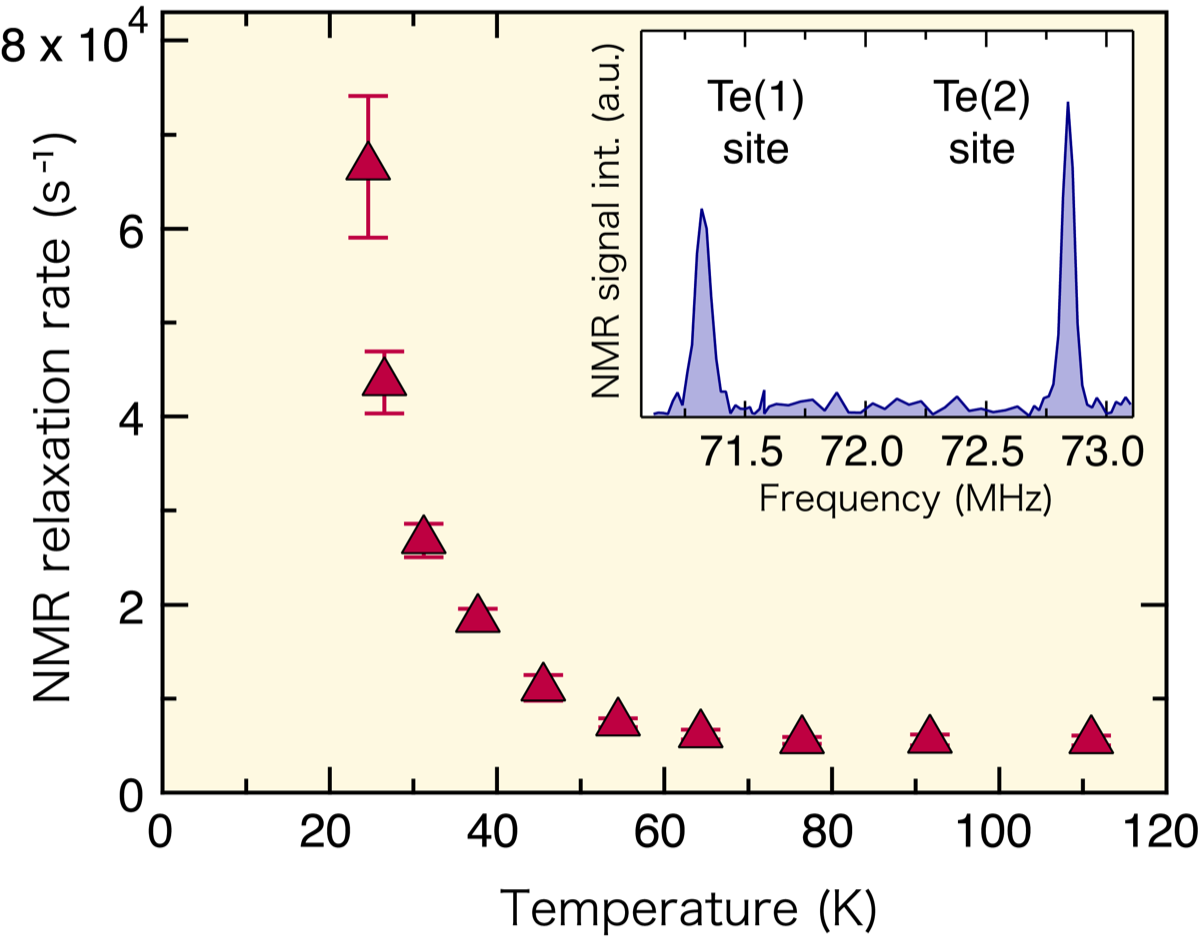Research Highlights
Currently here are:
・NMR study of UTe2
・PND and XMCD study of Ru substituted UCoGe
・NMR study on URh0.9Co0.1Ge
・NMR study of UTe2
・PND and XMCD study of Ru substituted UCoGe
・NMR study on URh0.9Co0.1Ge

Uranium, known for its usage as a nuclear fuel, has recently attracted a great deal of attention in the field of basic research on superconductivity. After the first discovery of superconductivity in mercury by Kamerlingh Onnes in 1911, many new superconductors have been discovered, including copper oxide and iron-based superconductors. From these discoveries, it has become clear that the mechanism behind superconductivity is far more diverse than originally thought. Since 2000, a variety of unconventional superconducting phenomena have been found in compounds containing uranium. Investigating one such phenomenon has allowed for the detailing of the spin-triplet superconductivity present in uranium compounds. The essence of superconductivity is that two electrons form a pair (i.e., a superconducting pair), with making collective motion in materials. As shown in Fig.1 (a), in conventional, spin-singlet superconductors, the spins of superconducting pairs are all antiparallel and thus the total spin moment is equal to zero. On the other hand, in a spin-triplet superconducting state, the spins are parallel and the total spin moment is equal to one (Fig.1 (b)). As a result, ferromagnetism and superconductivity, which has generally been considered as mutually exclusive phenomena, can coexist in the microscopic state in the spin-triplet superconductors. Furthermore, while a field will typically destroy superconductivity, field-induced superconductivity has been observed with spin-triplet pairs. In 2018, a new spin-triplet superconductor, UTe2 was discovered. Since then, a variety of unconventional superconducting phenomena has been found in UTe2. To reveal the origin of these phenomena, intensive studies are now being undertaken by researchers in Japan, in the United States, across the European Union, and in other countries. In an effort to study the electronic states of UTe2 from a microscopic viewpoint, nuclear magnetic resonance (NMR) experiments using a single crystal were conducted. The observed NMR spectrum is shown in the inset of Fig.2; here, two NMR peaks are present, arising from the two inequivalent Te sites in a unit cell. Both peaks are very sharp, confirming the high quality of the single crystal. Using the observed NMR signal, the temperature dependence of the NMR relaxation rate, 1/T2 , was measured and is displayed in Fig.2. The relaxation rate of 1/T2 is a physical quantity reflecting the strength of the magnetic fluctuations created by electron spins at the observed nuclear position. The measurements revealed the development of strong magnetic fluctuations along a specific axial direction of the crystal at low temperatures, where superconductivity appears. This implies that the magnetic fluctuations may create the attractive force of the spin-triplet pairing, as has been theorized since the 1980s. Recently, UTe2 has been suggested to have potential applications in next-generation quantum computing devices. This study was supported by Grant-in-Aid for Scientific Research (S) (No.15H05745) “Understanding of the Superconducting Mechanism and Search for a Novel Superconducting State in Uranium Heavy-Fermion Compounds’’ from the Japan Society of the Promotion of Sciences (JSPS).
Reference: “125Te-NMR Study on a Single Crystal of Heavy Fermion Superconductor UTe2”, Y. Tokunaga, H. Sakai, S. Kambe, T. Hattori, N. Higa, G. Nakamine, S. Kitagawa, K. Ishida, A. Nakamura, Y. Shimizu, Y. Homma, D.-X Li, F. Honda, and D. Aoki, J. Phys. Soc. Jpn. 88, 073701 (2019).

In general, superconducting pairs adopt a spin-singlet state, in which the spins of the pairs are all antiparallel (a). However, in some uranium compounds, superconducting pairs adopt a spin-triplet state, in which the spins of the pairs are all parallel (b).

Under an applied magnetic field, the development of magnetic fluctuations in the material leads to the increase of the NMR relaxation rate (1/T2) at low temperatures. Two NMR peaks corresponding to the two inequivalent Te sites in a crystal were observed, as shown in the inset figure.

The group of the uranium FM SC contains to date three members - UGe2, URhGe and UCoGe. In particular, URhGe and UCoGe have attracted much attention in recent years because they exhibit coexistence of weak long-range ferromagnetic order and superconductivity at ambient pressure. FM state of parent UCoGe is rather complex as Co exhibits a moment and thus significantly contributes to the total ordered magnetic moment. Therefore, UCoGe has been the subject of recent experimental and theoretical efforts: in particular polarized neutron diffraction (PND) experiments on UCoGe at 0.1 K and magnetic field of 12 T showed an induced moment on the Co site that compares to the uranium moment and is antiparallel to it. However the reported polarization of the Co magnetic moment antiparallel to the U magnetic moment contrast with the behavior found in related ferromagnetic UTX (X = Al, Ga, Si, Ge) compounds. In the present work, we study the evolution of the FM state of Ru substituted UCoGe using PND and XMCD measurements to confirm the orientation of U and Co moments. The ultimate aim of our study is to generalize the results to related isostructural ferromagnetic UTX compounds. On the basis of our PND data in combination with the macroscopic measurements, we conclude that the values of TC and µspont. in TiNiSi-type UTX compounds are determined by the strength of the 5f-d hybridization and the corresponding localization of the 5f states. Our PND results support the scenario that the initial stabilization of FM in URh1-xCoxGe is realized via a growth of uranium orbital moment and the consequent localization of the 5f states on U site. This can also be generalized to other FM alloys with TiNiSi-structure such as UCo1-xFexGe, URh1-xCoxGe and URh1-xRuxGe. In contrast, our PND study suggests the existence of a Co magnetic moment parallel to the uranium moment in high magnetic field supported by XMCD results. Detail research of the Co induced moment method is in progress by XMCD method. Our paper has been published on JPSJ as a full paper:
“Gradual Localization of 5f States in Orthorhombic UTX Ferromagnets:Polarized Neutron Diffraction Study of Ru Substituted UCoGe”, M. Vališka, J. Pospíšil, A. Stunault, Y. Takeda, B. Gillon, Y. Haga, K. Prokeš, M. M. Abd-Elmeguid, G. Nénert, T. Okane, H. Yamagami, L. Chapon, A. Gukasov, A. Cousson, E. Yamamoto, and V. Sechovský, J. Phys. Soc. Jpn. 84, 084707 (2015).

The occurrence of superconductivity in an itinerant ferromagnet, with the same electrons involved in both types of phase transition, is a counterintuitive idea. It is only during the last decade that such a paradox has found realization in a new family of uranium (U) based heavy fermion compounds, namely UGe2, URhGe and UCoGe. Among these, URhGe is by far the most intriguing: reentrant superconductivity (RSC) appears when a magnetic field of the order of 12 T is applied along the b axis, that is, perpendicular to the c axis direction along which the U 5f spin moments align ferromagnetically with a strong Ising character at zero field. Our measurements of the 59Co NMR spin-spin relaxation in URh0.9Co0.1Ge reveal a divergence of electronic spin fluctuations in the vicinity of the field-induced quantum critical point at HR=13 T, around which the RSC occurs in URhGe. We map out the strength of spin fluctuations in the (Hb, Hc) plane of magnetic field components and show that critical fluctuations develop in the same limited region near the field HR as that where RSC is observed. This strongly suggests these quantum fluctuations as the pairing glue responsible for the RSC. The fluctuations observed are characteristic of a tricritical point, followed by a phase bifurcation toward quantum critical end points. Our paper has been published on PRL as an Editors' Suggestion:
“Reentrant Superconductivity Driven by Quantum Tricritical Fluctuations in URhGe: Evidence from 59Co NMR in URh0.9Co0.1Ge”, Y. Tokunaga, D. Aoki, H. Mayaffre, S. Krämer, M.-H. Julien, C. Berthier, M. Horvatić, H. Sakai, S. Kambe and S. Araki, Phys. Rev. Lett. 114, 216401 (2015).
